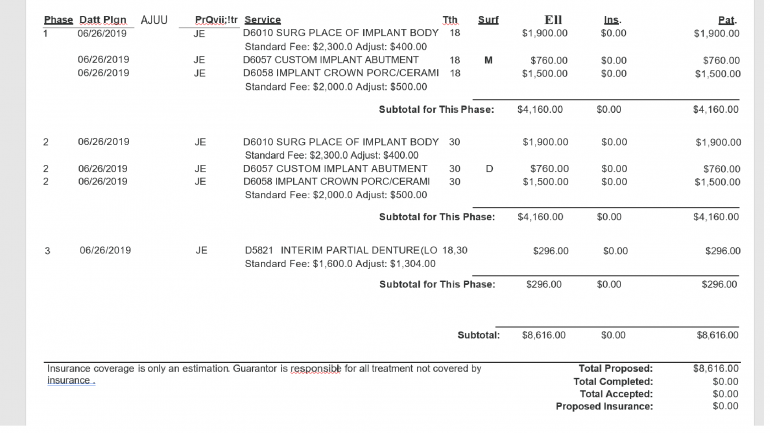
7261: Dental Code D7261: Primary closure of a sinus perforation
Dental Code D7261 specifically pertains to the primary closure of a sinus perforation, a dental procedure designed to repair and close any perforations or openings in the sinus membrane that may occur during certain dental treatments.
Detailed Information about the Procedure and Steps
Dental Code D7261 involves the primary closure of sinus perforations, which are openings in the sinus membrane that may occur during dental treatments. This procedure aims to repair and seal the perforation to prevent the passage of oral fluids and bacteria into the sinus cavity. It includes steps such as diagnosis and evaluation, anesthesia and access, sinus exploration, debridement and cleaning, repair and primary closure, and postoperative care. Understanding this dental code helps patients comprehend the treatment process and its significance in addressing sinus perforations. It is important to consult with a qualified dentist for personalized evaluation and treatment.
Diagnosis and Evaluation
Before commencing the treatment, the dentist conducts a comprehensive examination and evaluates the patient's dental and medical history. This step helps to identify any pre-existing conditions such as sinusitis or nasal polyps that may impact the treatment approach. Diagnostic tools, such as X-rays or cone-beam computed tomography (CBCT) scans, are employed to assess the extent and location of the sinus perforation.
Anesthesia and Access
To ensure the patient's comfort throughout the procedure, local anesthesia is administered to numb the area surrounding the affected tooth. Once the anesthesia takes effect, the dentist creates a small incision in the gum tissue near the site of the sinus perforation. This incision provides access to the affected area for further examination and treatment.
Sinus Exploration
Using specialized instruments, the dentist carefully explores the sinus cavity to locate the exact position and characteristics of the sinus perforation. This step is crucial in determining the size, shape, and location of the perforation, which helps guide subsequent treatment decisions. Sinus exploration is a critical step in the dental code D7261 procedure as it allows the dentist to gain a comprehensive understanding of the sinus perforation. Specialized instruments are used to carefully navigate the sinus cavity, enabling the dentist to precisely locate the exact position and characteristics of the perforation. By assessing the size, shape, and location of the perforation, the dentist can make informed decisions regarding the most appropriate repair technique and ensure optimal closure of the sinus membrane. This meticulous exploration helps minimize the risk of complications and ensures a successful outcome for the patient.
Debridement and Cleaning
After identifying the sinus perforation, the dentist meticulously removes any debris, foreign particles, or infected material from the affected area. Thorough cleaning is essential to eliminate potential sources of infection and promote optimal healing of the sinus membrane. Debridement and cleaning are vital steps in the dental code D7261 procedure, ensuring the removal of any debris, foreign particles, or infected material from the site of the sinus perforation. The dentist exercises great care and precision to meticulously clean the affected area, leaving it free from potential sources of infection. This thorough cleaning is crucial as it creates an environment conducive to optimal healing of the sinus membrane. By eliminating contaminants, the dentist enhances the chances of successful primary closure and reduces the risk of complications, ultimately promoting the patient's overall oral health and well-being.
Repair and Primary Closure
The repair technique employed for the sinus perforation depends on its size, location, and other individual factors. One common approach involves suturing the perforation using either resorbable or non-resorbable sutures. Resorbable sutures gradually dissolve over time, eliminating the need for their removal, while non-resorbable sutures require a subsequent visit for removal. The primary closure achieved through suturing ensures that the sinus membrane is properly sealed, preventing the passage of oral fluids and bacteria into the sinus cavity.
Postoperative Care
Following the primary closure of the sinus perforation, the dentist may prescribe antibiotics to minimize the risk of infection. Nasal sprays or rinses may also be recommended to maintain sinus health and reduce inflammation. Pain medication or anti-inflammatory drugs may be prescribed to manage any discomfort experienced by the patient. Detailed postoperative instructions regarding oral hygiene practices and dietary restrictions will be provided to facilitate proper healing and minimize the risk of complications.
Summary of Dental Code D7261
Dental Code D7261 involves the primary closure of sinus perforations, a dental procedure focused on repairing and closing openings in the sinus membrane that may occur during dental treatments. The process begins with a comprehensive diagnosis and evaluation, followed by anesthesia and access to the affected area. The sinus cavity is carefully explored, and any debris or infected material is removed through thorough cleaning. The sinus perforation is repaired using sutures, achieving primary closure and preventing the passage of oral fluids and bacteria into the sinus cavity. Postoperative care, including antibiotic use, nasal sprays, and pain management, is crucial for a successful recovery.
By gaining a comprehensive understanding of the step-by-step process involved in dental code D7261, patients can be better informed about this specific dental procedure and its significance in addressing sinus perforations. It is important to consult with a qualified dentist to evaluate individual dental needs and determine the most appropriate course of treatment.
Ready to make your dental dollars stretch further? Let Dr. BestPrice be your guide.
